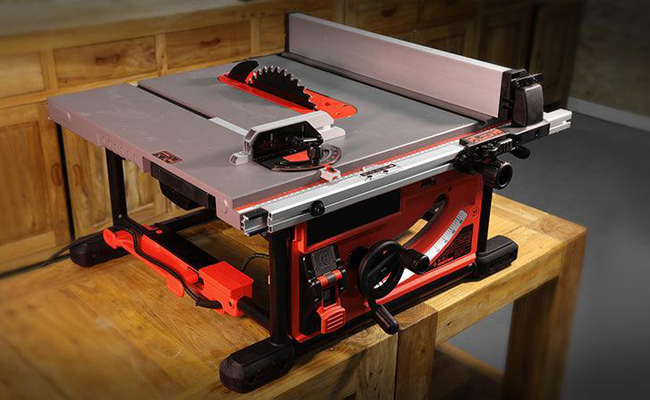BS-1018TH Metal Cutting Bandsaw
Cutting Capacity :
Let’s break down the strengths, weaknesses, and ideal use cases for each.

| Feature | Table Saw | Band Saw |
|---|---|---|
| Primary Strength | Straight, accurate cuts (rips, crosscuts, dados). The heart of a woodshop. | Curved cuts and resawing (splitting thick wood into thinner boards). |
| Best For | Sheet goods (plywood), joinery (dadoes, rabbets), dimensioning lumber, repeatable cuts. | Cutting curves, irregular shapes, rough-cutting thick stock, intricate work. |
| Cut Type | Primarily straight lines. | Straight lines, curves, and irregular shapes. |
| Accuracy | Excellent for straight-line ripping and cross-cutting. | Good for curves, less ideal for precise, long rip cuts. |
| Safety | Considered one of the most dangerous tools. Kickback is a major hazard. | Generally safer. No kickback, and the blade moves downward, pulling the workpiece firmly onto the table. |
| Key Limitation | Cannot cut tight curves. The blade is a fixed disk. | Struggles with ultra-precise, long, straight rips (like breaking down sheet goods). |
The table saw is often called the “workhorse” of the workshop for a reason.
Why you should get a table saw first:
Unmatched Versatility for Furniture & Cabinets: If you plan to build things like bookshelves, tables, cabinets, or frames, the table saw is indispensable. It’s the best tool for breaking down large sheets of plywood.
Precision and Repeatability: With a fence and a miter gauge, you can make dozens of identical, perfectly straight cuts. This is crucial for professional-looking results.
Joinery Capabilities: You can cut dadoes, rabbets, and tenons with a table saw (often with simple jigs), which are the foundation of strong woodworking joints.
Power and Speed: It can handle large, thick stock with relative ease and makes quick work of long rip cuts.
Downsides of a Table Saw:
Danger: It demands immense respect. Kickback can be violent and dangerous. Proper technique, a riving knife, and a splitter are essential.
Dust Collection: It creates a huge amount of dust that needs to be managed.
Limited to (mostly) Straight Lines: You cannot cut curves.
Space: A good cabinet-style table saw requires a significant footprint.
The band saw is the sculptor’s tool—incredibly useful for specific tasks that other saws can’t handle.
Why you might consider a band saw first:
The King of Curves: If your projects involve organic shapes, scrollwork, or any kind of curved design (e.g., chair legs, toy cars, decorative pieces), the band saw is your best friend.
Resawing: This is a massive advantage. You can take a thick piece of expensive lumber and slice it into several thinner boards for bookmatched panels or veneers. No other common shop tool does this as well.
Safety: It is inherently safer than a table saw. The downward-cutting motion minimizes kickback, and it’s much less intimidating for beginners.
Versatility with Materials: With the right blade, a band saw can cut wood, metal, and plastics.
Rough Stock Breakdown: It’s great for cutting rough, live-edge slabs or thick stock to a more manageable size.
Downsides of a Band Saw:
Not for Sheet Goods: Trying to rip a 4×8 sheet of plywood on a band saw is impractical and inaccurate.
Less Precision on Long Cuts: The flexible, continuous blade can drift, making it difficult to get a perfectly straight edge over a long distance.
Slower for Straight Cuts: While it can cut straight lines, it’s significantly slower than a table saw for ripping a stack of boards.
Get a TABLE SAW first if you:
Plan to build cabinets, bookshelves, or furniture with straight lines.
Need to break down large sheets of plywood.
Value precision, repeatability, and speed for straight cuts.
Want to perform advanced joinery like dadoes and rabbets.
Are building a general-purpose woodshop for “making things square.”
Get a BAND SAW first if you:
Are primarily interested in making curved projects, toys, or artistic pieces.
Work with rough-sawn lumber and want to resaw your own wood.
Prioritize safety and are nervous about starting with a more dangerous tool.
Work with a variety of materials beyond just wood (e.g., metal).
Have a specialized focus like lutherie (building guitars) or bow making.
For the vast majority of people starting a workshop, the table saw is the correct first choice. It establishes the foundation for accurate, square work that nearly every project requires. It’s very difficult to build a cabinet or a table without one, but you can certainly build one without a band saw.
However, a band saw is very often the best second major tool purchase. Once you have a table saw to handle your straight-line and sheet-good work, adding a band saw opens up a whole new world of design possibilities and resawing capabilities.
Final Verdict:
Start with a quality table saw. Learn to use it safely and respect its power. Then, as your skills and project ambitions grow, add a band saw to complement it. This 1-2 punch will give you about 90% of the cutting capability needed for a huge range of projects.
Cutting Capacity :
Cutting Capacity :